Manual pelvic massage is a therapeutic approach focusing on the muscles and tissues of the pelvic region. It aims to relieve tension, improve circulation, and enhance overall pelvic health. Regular sessions can address discomfort and promote well-being.
Definition and Purpose
Manual pelvic massage is a therapeutic technique targeting the pelvic area to relieve muscle tension and enhance circulation. Its primary purpose is to address pelvic floor dysfunction, chronic pain, and improve overall pelvic health. Administered by trained professionals, it offers a non-invasive approach to restoring comfort and function. Regular sessions can lead to significant improvements in well-being.
Benefits for Pelvic Health
Manual pelvic massage offers numerous benefits, including relief from pelvic floor dysfunction and chronic pain. It enhances blood flow, relaxes tight muscles, and improves bladder and bowel function. Regular sessions can reduce discomfort, restore muscle tone, and promote a healthier pelvic region. This non-invasive approach is particularly effective for addressing pain points and improving overall well-being.
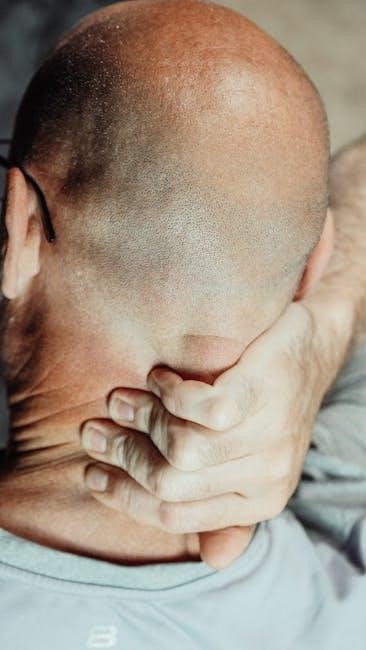
Techniques and Methods
Manual pelvic massage involves various techniques, including internal and external methods, tailored to address specific pelvic health needs. Techniques are applied with precision and care, focusing on muscle relaxation and improved function. These methods require expertise to ensure effectiveness and safety.
Internal vs. External Massage Techniques
Internal pelvic massage targets muscles inside the pelvic cavity, often requiring specialized training, while external techniques focus on surface muscles and connective tissue. Internal methods may involve gentle, precise pressure to release tension, while external techniques use strokes and manipulations to relax superficial muscles. Both approaches aim to improve pelvic function, but internal techniques are typically performed by trained professionals due to their invasive nature. External methods are often more accessible and can be incorporated into self-care routines.
Target Areas for Pelvic Massage
Manual pelvic massage focuses on key areas like the pelvic floor muscles, lower back, and abdominal regions. Techniques target the pubococcygeus muscle, sacrum, and surrounding soft tissues to alleviate tension. Massaging these areas improves circulation, reduces muscle spasms, and addresses painful trigger points. Proper targeting enhances pelvic mobility, relieves discomfort, and supports overall pelvic health by addressing both superficial and deeper tissues effectively.
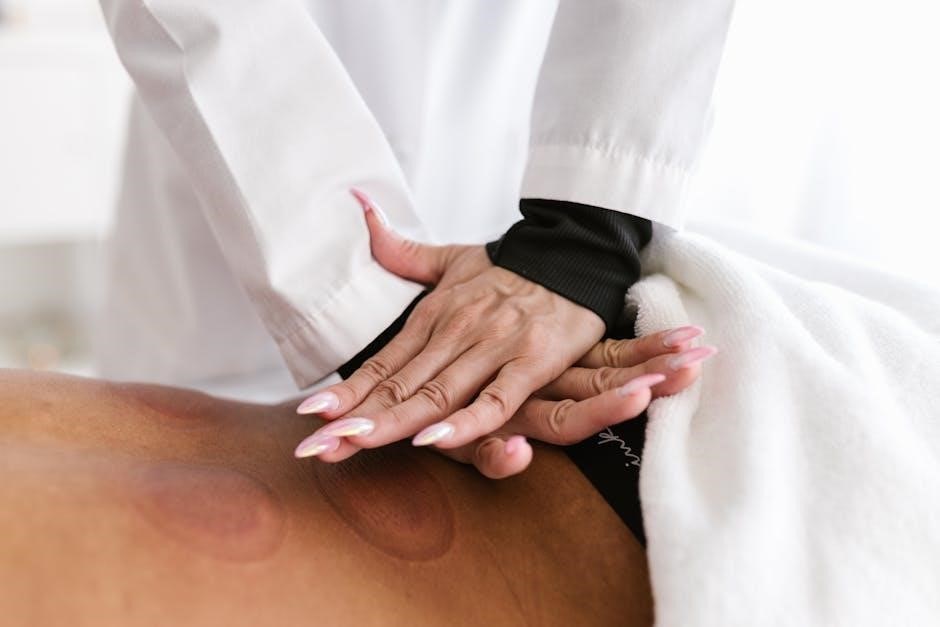
Who Performs Pelvic Massage?
Pelvic massage is typically performed by pelvic health physical therapists or trained massage therapists. These professionals specialize in addressing pelvic floor dysfunction and muscle imbalances effectively.
Role of Pelvic Health Physical Therapists
Pelvic health physical therapists specialize in addressing pelvic floor dysfunction and related conditions. They use manual massage techniques to release muscle tension, improve circulation, and restore proper pelvic alignment. These professionals often perform internal assessments to evaluate muscle tone and develop personalized treatment plans. Their expertise helps alleviate chronic pain, enhance bladder and bowel function, and improve overall pelvic health. Regular sessions with a trained therapist can significantly reduce symptoms of pelvic floor dysfunction.
Massage Therapists and Their Expertise
Massage therapists bring specialized skills to manual pelvic massage, focusing on soft tissue manipulation and trigger point therapy. They are trained to identify and release tension in pelvic muscles, enhancing circulation and relaxation. Their expertise often includes techniques to alleviate discomfort and improve pelvic floor function. While their primary goal is therapeutic, they maintain professional boundaries to ensure safe and effective treatment. Their work complements other therapies, promoting overall pelvic well-being.

Conditions Treated with Manual Pelvic Massage
Manual pelvic massage effectively addresses pelvic floor dysfunction, chronic pelvic pain, and constipation by relieving muscle tension and improving blood flow.
Pelvic Floor Dysfunction
Manual pelvic massage is effective in managing pelvic floor dysfunction by targeting tight muscles and improving blood flow. Techniques such as gentle stretching and trigger point therapy help relax the pelvic muscles, reducing pain and discomfort. Regular sessions can restore normal muscle function and alleviate symptoms associated with PFD. This approach is often recommended by pelvic health professionals to enhance overall pelvic well-being and improve quality of life for those affected.
Chronic Pelvic Pain Relief
Manual pelvic massage offers significant relief for chronic pelvic pain by addressing muscle tension and promoting relaxation. Techniques like soft tissue mobilization and trigger point therapy help ease discomfort, improving circulation and reducing inflammation. Regular sessions can enhance the body’s natural healing processes, providing long-term pain management and improving quality of life for individuals suffering from persistent pelvic discomfort.
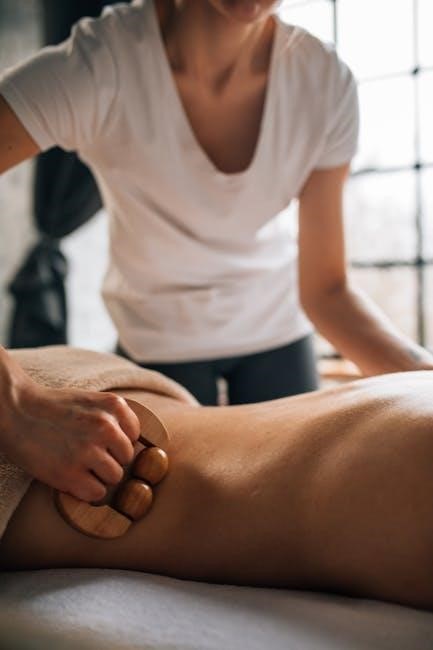
Contraindications and Precautions
Manual pelvic massage should be avoided during active infections, severe injuries, or acute inflammation. It’s also contraindicated in cases of undiagnosed pelvic pain or certain medical conditions.
When to Avoid Pelvic Massage
Manual pelvic massage should not be performed during active infections, severe injuries, or acute inflammation. It is also contraindicated in cases of undiagnosed pelvic pain or certain medical conditions. Pregnant individuals, especially in early stages, and those with recent pelvic surgeries should avoid internal massage. Additionally, individuals with osteoporosis or fragile pelvic bones should exercise caution. Consulting a healthcare provider is essential to determine safety and appropriateness.
Risks and Side Effects
Manual pelvic massage may cause temporary discomfort or soreness, especially during initial sessions. Improper technique can lead to muscle spasms or nerve irritation. Overly aggressive massage may exacerbate existing pelvic conditions. There is a risk of bruising or discomfort if pressure is applied too intensely. In rare cases, it may trigger emotional responses due to the sensitive nature of the area; Always ensure the practitioner is trained and experienced to minimize these risks.
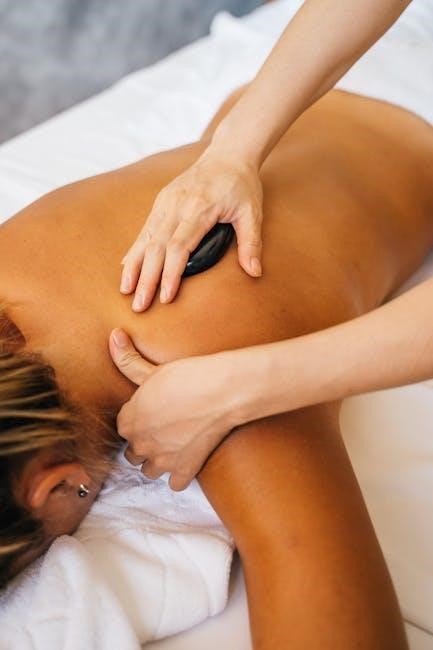
Preparing for a Pelvic Massage Session
Wear comfortable clothing and arrive hydrated. Eat a light meal beforehand and avoid heavy meals. Arrive early to complete paperwork and discuss concerns with your therapist.
What to Expect During the Session
A trained therapist will guide you through a comfortable and private session. They may use internal or external techniques to release tension in pelvic muscles. Communication is key to ensure comfort. The session typically lasts 30-60 minutes, focusing on relieving pain and improving muscle function. You may experience mild discomfort during trigger point release, but it should ease as tension is alleviated. The goal is to promote relaxation and improve pelvic floor mobility.
Mental and Physical Preparation
Mentally, it’s important to relax and stay open-minded. Engage in deep breathing or meditation to ease anxiety. Physically, practice pelvic floor exercises to strengthen muscles. Maintain proper posture and wear comfortable clothing. Communicate openly with your therapist to ensure a personalized experience. Arrive early to complete any necessary paperwork. Proper preparation enhances the effectiveness of the massage and promotes a positive outcome.

Aftercare and Follow-Up
Post-massage, rest and hydration are essential. Gentle stretching and pelvic floor exercises can enhance results. Communicate with your therapist for personalized advice. Follow-up sessions ensure sustained progress and address any new concerns. Consistency is key to maintaining pelvic health and preventing future discomfort. Proper aftercare supports long-term benefits and overall well-being.
Post-Massage Care Tips
After a pelvic massage, rest and hydration are crucial to flush out toxins. Gentle stretching and light activities are recommended to maintain muscle relaxation. Avoid intense exercise for 24 hours. Listen to your body and avoid heavy lifting or prolonged sitting. Communicate with your therapist about any discomfort or sensations. Applying warmth to the pelvic area can soothe lingering tension. Prioritize sleep to aid muscle recovery and overall well-being.
Importance of Consistency
Consistency in manual pelvic massage is vital for achieving lasting relief and improving pelvic health. Regular sessions help maintain muscle relaxation, prevent tension buildup, and promote long-term well-being. Over time, consistent practice enhances the body’s response to treatment, reducing the recurrence of pain and discomfort. Working with a therapist to establish a routine ensures sustained benefits and supports overall pelvic floor health effectively.

Self-Techniques and Home Practice
Self-techniques for manual pelvic massage involve gentle, guided exercises that can be practiced at home to maintain pelvic health and relieve tension between sessions.
DIY Pelvic Massage Techniques
DIY pelvic massage involves gentle, self-administered exercises targeting the pelvic floor and surrounding muscles. Techniques include abdominal and lower back massage to relieve tension. Use fingertips or soft tools to apply pressure. Focus on areas of discomfort, massaging in circular motions. Practice breathing exercises to enhance relaxation. Regular practice can improve circulation, reduce pain, and promote pelvic floor awareness. Consistency is key for long-term benefits and overall pelvic health.
Integrating Massage into Daily Routine
Integrating manual pelvic massage into your daily routine can enhance overall pelvic health. Start with short sessions, such as 5-10 minutes, during cooldowns post-exercise or while practicing relaxation techniques. Incorporate gentle self-massage during downtime, like after bathing or before bed. Use deep breathing to relax muscles and improve focus. Consistency is key; regular practice helps maintain muscle balance, reduces tension, and promotes long-term pelvic well-being.
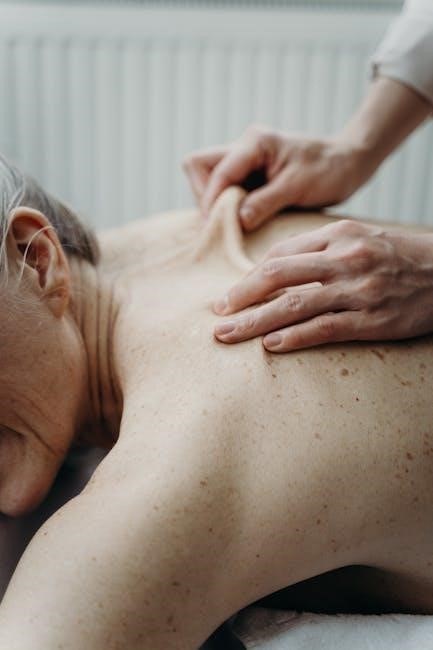
Testimonials and Success Stories
Many individuals have shared positive experiences with manual pelvic massage, highlighting its role in alleviating chronic pain and improving pelvic health. Patients often report enhanced well-being and empowerment through regular sessions, emphasizing its transformative impact on their quality of life.
Real-Life Experiences with Pelvic Massage
Many individuals have reported significant relief from chronic pelvic pain and improved muscle function through manual pelvic massage. Patients share stories of reduced discomfort and enhanced emotional well-being, often describing a renewed sense of empowerment; With consistent practice, many have found long-term benefits, highlighting pelvic massage as a transformative approach supported by professional techniques, leading to a noticeable improvement in their overall quality of life.
Expert Endorsements
Pelvic health physical therapists and specialists highly recommend manual pelvic massage for addressing pelvic floor dysfunction and chronic pain. Many experts endorse its benefits, citing improved muscle tone and pain relief. Professionals often integrate pelvic massage into treatment plans, emphasizing its effectiveness in restoring function and comfort. Their endorsements highlight the therapeutic value of this approach in promoting long-term pelvic health and well-being for individuals seeking relief from pelvic-related discomfort.